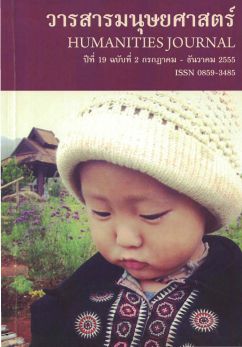การเว้นระยะห่างจากผู้ฟังหรือผู้อ่านในภาษากฎหมาย ภาษาการเมือง ภาษาสื่อ และภาษาวิชาการของไทย
Main Article Content
Abstract
บทความนี้มีวัตถุประสงค์เพื่อวิเคราะห็ลักษณะทางภาษาที่แสดงการเว้นระยะห่างจากผู้ฟังหรือผู้อ่าน ในทำเนียบภาษากฎหมาย ภาษาการเมือง ภาษาสื่อ และภาษาวิชาการของไทย ข้อมูลที่ใช้ได้มากจากรัฐธรรมนูญแห่งราชอาณาจักรไทย พุทธศักราช 2550 (สำนักงานคณะกรรมการกฤษฏีกา, 2555) แถลงการณ์ของนายกรัฐมนตรีและพรรคการเมืองต่างๆ ตั้งแต่ พ.ศ. 2549-2555 (พรรคการเมืองใหม่, 2554; พรรคความหวังใหม่, 2554; พรรคประชาธิปัตย์, 2554ก, 2554ข, 2554ค, 2554ง; พรรคเพื่อไทย, 2554; รัฐบาลไทย, 2555) โฆษณาในนิตยสารและหนังสือพิมพ์ระหว่างเดือนพฤศจิกายน-ธันวาคม พ.ศ. 2554 (กูร์เมท์ แอนด์ ควีซีน, 2554; เดลินิวส์, 2554; ไทยรัฐ, 2554; แพรว, 2554; มติชน, 2554) และบทความในวารสารวิทยาศาสตร์ซึ่งตีพิมพ์ระหว่างปี พ.ศ.2550-2551 (คมธัช หวังดำรงเวศ, 2550; จินตนา ศริริชุมพันธ์, สุคนธา เจริญวิทย์, กมล จรัลนามศิริ และธนิตย์ เซียรจรัสวงศ์, 2550; ธนากร เมธาธรรม และชวลิต รัตนธรรมกุล, 2550; ศิริพร ศิริกาญจนโกวิท และถนอมวงศ์ กฤษณ์เพ็ชร์, 2551) ผลการวิเคราะห์พบตัวบ่งชี้ 3 ประเภทใหญ่ๆ ที่แสดงการเว้นระยะห่างจากผู้ฟังหรือผู้อ่าน ได้แก่ 1) คำสรรพนาม 2) นามวลีแปลง และ 3) ประโยคกรรมวาจก การใช้ตำสรรพนามเป็นการแสดงความสนิทสนมกับผู้ฟังหรือผู้อ่าน ผลการวิเคราะห์พบว่า มีเพียงภาษาการเมืองและภาษาสื่อเท่านั้นที่้คำสรรพนามเพื่อแสดงความสนิทสนมกับผู้ฟังหรือผู้อ่าน ส่วนนามวลีแปลงและประโยคกรรมวาจกปรากฏในทุกทำเนียบภาษา โดยพบว่าภาษาวิชาการใช้นามวลีแปลงมากที่สุด และภาษากฎหมายใช้ประโยคกรรมวาจามากที่สุด ผลการวิเคราะห์ความถี่ปรากฏของนามวลีแปลงร่วมกับประโยคกรรมวาจกแสดงให้เห็นว่าทำเนียบภาษาวิชาการมีลักษณะเว้นระยะห่างจากผู้อ่านมากที่สุด ในขณะที่ภาษาสื่อมีลักษณะการเว้นระยะห่างจากผู้อ่านน้อยที่สุด
Interpersonal Distance in Thai Legal Language, Political Language, Media Language and Academic Language
Natchanan Natpratan
This article aims to analyze linguistic features that signify interpersonal distance in four types of texts, namely, legal texts, political texts, media texts and academic texts. The data were taken from The Constitution of the Kingdom of Thailand B.E. 2550 (Office of the Council of State of Thailand, 2555), the prime ministers’ and the political parties’ official statements during B.E. 2549-2555 (New Politics Party, 2554; New Aspiration Party, 2554; Democrat Party, 2554ก, 2554ข, 2554ค, 2554ง; Pheu Thai Party, 2554; The Royal Thai Government, 2555), the newspaper advertisements and the magazine advertisements published during November to December B.E. 2554 (Gourmet and Cuisine, 2554; Daily News, 2554; Thairath, 2554; 2550-2551 (Wangdamrongwet, 25500; Sirichumphan, Charoenwit, Charannamsiri and Chiancharatwong, 2 5 5 0 ; Methatham and Rattanathamkun, 2 5 5 0 ; SirikanchanaKowit and Kritphet, 2551). It is found that the interpersonal distance in all types of texts is marked by three different ways, that is, the lack of personal pronouns, the use of nominalized noun phrases and the use of passive constructions. There is no personal pronoun in the legal texts and the academic texts whereas the political texts and the media texts show some percentages of pronouns. It is also found that the academic texts show the highest frequency of nominalized noun phrases and the legal texts show the highest use of passive constructions. In addition, when counting the frequency of the occurrence of the nominalized noun phrases together with passive constructions, it is found that the academic language is the most distant text type whereas the media language is the least distant text type.

